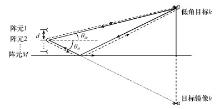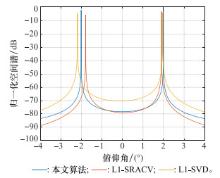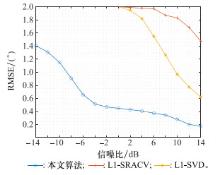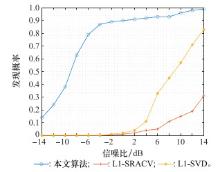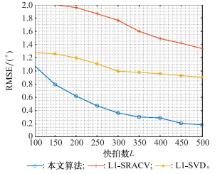Systems Engineering and Electronics ›› 2021, Vol. 43 ›› Issue (5): 1218-1223.doi: 10.12305/j.issn.1001-506X.2021.05.08
• Sensors and Signal Processing • Previous Articles Next Articles
Low elevation angle estimation algorithm for MIMO radar based on sparse reconstruction of cross-covariance
Zixin ZHANG1,2,*( ), Guoping HU1(
), Guoping HU1( ), Hao ZHOU1(
), Hao ZHOU1( ), Chenghong ZHAN1,2(
), Chenghong ZHAN1,2( )
)
- 1. Air and Missile Defense College, Air Force Engineering University, Xi'an 710051, China
2. Graduate College, Air Force Engineering University, Xi'an 710051, China
-
Received:2020-06-15Online:2021-05-01Published:2021-04-27 -
Contact:Zixin ZHANG E-mail:403292363@qq.com;hgp6068@163.com;17792611529@qq.com;chenghong_zhan@163.com
CLC Number:
Cite this article
Zixin ZHANG, Guoping HU, Hao ZHOU, Chenghong ZHAN. Low elevation angle estimation algorithm for MIMO radar based on sparse reconstruction of cross-covariance[J]. Systems Engineering and Electronics, 2021, 43(5): 1218-1223.
share this article
| 1 | MERRILL I S . Introduction to radar system[M]. New York: McGraw Hill, 2001. |
| 2 | 黄馨誉, 胡士强, 郑世友. 基于PN学习的雷达目标鲁棒跟踪算法[J]. 传感器与微系统, 2016, 35 (12): 116- 118. |
| HUANG X Y , HU S Q , ZHENG S Y . Robust tracking algorithm for radar target based on PN-learning[J]. Transducer and Microsystem Technologies, 2016, 35 (12): 116- 118. | |
| 3 |
陈浩文, 黎湘, 庄钊文. 一种新兴的雷达体制—MIMO雷达[J]. 电子学报, 2012, 40 (6): 1190- 1198.
doi: 10.3969/j.issn.0372-2112.2012.06.021 |
|
CHEN H W , LI X , ZHUANG Z W . A rising radar system-MIMO radar[J]. Acta Electronica Sinica, 2012, 40 (6): 1190- 1198.
doi: 10.3969/j.issn.0372-2112.2012.06.021 |
|
| 4 |
李仙茂, 董天临, 黄高明. MIMO雷达及其特性综述[J]. 现代防御技术, 2015, 43 (4): 124- 131.
doi: 10.3969/j.issn.1009-086x.2015.04.021 |
|
LI X M , DONG T L , HUANG G M . Introduction of MIMO radar and its character[J]. Modern Defense Technology, 2015, 43 (4): 124- 131.
doi: 10.3969/j.issn.1009-086x.2015.04.021 |
|
| 5 |
XU J W , LIAO G S , ZHU S Q . Joint range and angle estimation using MIMO radar with frequency diverse array[J]. IEEE Trans.on Signal Processing, 2015, 63 (13): 3396- 3410.
doi: 10.1109/TSP.2015.2422680 |
| 6 | 张孝霖, 郭文轩. 在海域红外杂波背景中小目标探测的空间匹配滤波技术[J]. 红外与毫米波学报(自然科学), 1994, 13 (2): 95- 101. |
| ZHANG X L , GUO W X . Space matching filtering technique for small targets detection in infrared clutter background of sea area[J]. Journal of Infrared and Millimeter Waves, 1994, 13 (2): 95- 101. | |
| 7 |
SCHMIDT R . Multiple emitter location and signal parameter estimation[J]. IEEE Trans.on Antennas and Propagation, 1986, 34 (3): 276- 280.
doi: 10.1109/TAP.1986.1143830 |
| 8 |
ROY R , KAILATH T . ESPRIT-estimation of signal parameters via rotational invariance techniques[J]. IEEE Trans.on Acoustics, Speech and Signal Processing, 1989, 37 (7): 984- 995.
doi: 10.1109/29.32276 |
| 9 |
朱伟, 郑轶松, 陈伯孝. 约束MUSIC算法在米波雷达低仰角测高中的应用[J]. 安徽大学学报(自然科学版), 2014, 38 (4): 59- 65.
doi: 10.3969/j.issn.1000-2162.2014.04.010 |
|
ZHU W , ZHENG Y S , CHEN B X . Application of constrained MUSIC to the low-angle altitude measurement for VHF radar[J]. Journal of Anhui University (Natural Sciences), 2014, 38 (4): 59- 65.
doi: 10.3969/j.issn.1000-2162.2014.04.010 |
|
| 10 | 刘俊, 刘峥, 刘韵佛. 米波雷达仰角和多径衰减系数联合估计算法[J]. 电子与信息学报, 2011, 33 (1): 33- 37. |
| LIU J , LIU Z , LIU Y F . Elevation angle and multipath fading coefficient joint estimation algorithm in VHF radar[J]. Journal of Electronics & Information Technology, 2011, 33 (1): 33- 37. | |
| 11 | 何昭然, 高洪元. 文化鱼群算法的广义MUSIC测向技术[J]. 解放军理工大学学报(自然科学版), 2014, 15 (1): 7- 11. |
| HE Z R , GAO H Y . Generalized MUSIC direction finding techniques based on cultural Fish school algorithm[J]. Journal of PLA University of Science and Technology (Natural Science Edition), 2014, 15 (1): 7- 11. | |
| 12 | 刘俊, 刘峥, 谢荣, 等. 基于波束空间的米波MIMO雷达角度估计算法[J]. 电子学报, 2011, 39 (9): 1961- 1966. |
| LIU J , LIU Z , XIE R . Beam-space domain angle estimation algorithm in VHF MIMO radar[J]. Acta Electronica Sinica, 2011, 39 (9): 1961- 1966. | |
| 13 |
BENCHEIKH M L , WANG Y . Joint DOD-DOA estimation using combined ESPRIT-MUSIC approach in MIMO radar[J]. Electronics Letters, 2010, 46 (15): 1081- 1083.
doi: 10.1049/el.2010.1195 |
| 14 |
ZHANG X , XU D . Low-complexity ESPRIT-based DOA estimation for collocated MIMO radar using reduced dimension transformation[J]. Electronics Letters, 2011, 47 (4): 283- 284.
doi: 10.1049/el.2010.3279 |
| 15 |
DONOHO D L . Compressed sensing[J]. IEEE Trans.on Information Theory, 2006, 52 (4): 1289- 1306.
doi: 10.1109/TIT.2006.871582 |
| 16 | CANDES E J. Compressive sampling[C]//Proc. of the International Congress of Mathematicians, 2006: 1433-1452. |
| 17 |
CANDES E J , TAO T . Near-optimal signal recovery from random projections: universal encoding strategies[J]. IEEE Trans.on Information Theory, 2006, 52 (12): 5406- 5425.
doi: 10.1109/TIT.2006.885507 |
| 18 |
CANDES E J , ROMBERG J K , TAO T . Stable signal recovery from incomplete and inaccurate measurement[J]. Communications on Pure and Applied Mathematics, 2006, 59 (8): 1207- 1223.
doi: 10.1002/cpa.20124 |
| 19 |
MALIOUTOV D M , CETIN M , WILLSKY A S . A sparse signal reconstruct on perspective for source localization with sensor arrays[J]. IEEE Trans.on Signal Processing, 2005, 53 (8): 3010- 3022.
doi: 10.1109/TSP.2005.850882 |
| 20 |
YIN J H , CHEN T Q . Direction-of-arrival estimation using a sparse representation of array covariance vectors[J]. IEEE Trans.on Signal Processing, 2011, 59 (9): 4489- 4493.
doi: 10.1109/TSP.2011.2158425 |
| 21 |
MA W KIN , HSIEH T H , CHI C Y . DOA estimation of quasi-stationary signals with less sensors than sources and unknown spatial noise covariance: a Khatri-Rao subspace approach[J]. IEEE Trans.on Signal Processing, 2010, 58 (4): 2168- 2180.
doi: 10.1109/TSP.2009.2034935 |
| 22 | 徐略秋, 陈俊丽, 刘晓宇. 基于空域平滑的稀疏表示DOA估计[J]. 电子测量技术, 2019, 42 (45): 7- 11. |
| XU L Q , CHEN J L , LIU X Y . Sparse representation DOA estimation based on spatial smoothing[J]. Electronic Measurement Technology, 2019, 42 (45): 7- 11. | |
| 23 |
SALAMA A , AHMAD M , SWAMY M . Underdetermined DOA estimation using MVDR-weighted LASSO[J]. Sensors, 2016, 16 (9): 1549.
doi: 10.3390/s16091549 |
| 24 |
PAN J , FU J . Low complexity beamspace super resolution for DOA estimation of linear array[J]. Sensors, 2020, 20 (8): 1- 19.
doi: 10.1109/JSEN.2020.2978309 |
| 25 | 李建峰, 张小飞, 贲德. MIMO雷达中基于互协方差压缩感知的角度估计算法[J]. 中国电子科学研究院学报, 2013, 3 (8): 227- 232. |
| LI J F , ZHANG X F , BEN D . Algorithm for angle estimation in MIMO radar based on cross-covariance compressed sensing[J]. Journal of China Academy of Electronics and Information Technology, 2013, 3 (8): 227- 232. | |
| 26 |
BEKKERMAN I , TABRIKIAN J . Target detection and localization using MIMO radars and sonars[J]. IEEE Trans.on Signal Processing, 2006, 54 (10): 3873- 3883.
doi: 10.1109/TSP.2006.879267 |
| [1] | He TIAN, Chunzhu DONG, Hongcheng YIN. Radar target three-dimensional scattering centers inversion based on compressed sensing and frequency sparsity [J]. Systems Engineering and Electronics, 2022, 44(9): 2783-2790. |
| [2] | Jialei LIU, Jiazhi MA, Longfei SHI. DOA estimation algorithm based on fourth-order cumulant using virtual beam forming [J]. Systems Engineering and Electronics, 2022, 44(7): 2134-2142. |
| [3] | Zhiyu QU, Meng SUN, Huanyao DAI. Joint estimation algorithm of DOA and polarization information based on conformal array [J]. Systems Engineering and Electronics, 2022, 44(6): 1798-1804. |
| [4] | Juan WEI, Shian YAN, Fangli NING. DOA estimation method for coherent signals based on coprime array virtual array spatial smoothing [J]. Systems Engineering and Electronics, 2022, 44(4): 1069-1077. |
| [5] | Ailun XIE, Xiaobin LIU, Feng ZHAO, Xiaofeng AI, Shunping XIAO. Reconstruction method of PCM signal intermittent transmitting and receiving echo in radiation simulation [J]. Systems Engineering and Electronics, 2022, 44(3): 771-776. |
| [6] | Baohua FAN, Le ZUO, Yong TANG, Zehua HU. DOA estimation of multiple time-varying signals with expectation-maximization algorithm [J]. Systems Engineering and Electronics, 2022, 44(2): 420-426. |
| [7] | Tao CHEN, Lin SHI, Mengyu SHEN. Gridless DOA estimation algorithm based on M-FIPM [J]. Systems Engineering and Electronics, 2022, 44(2): 427-433. |
| [8] | Hai LI, Ze HUYAN, Zhijie MAO. Low-altitude wind-shear velocity ambiguity resolution based on compressed sensing under strong clutter [J]. Systems Engineering and Electronics, 2022, 44(10): 3029-3036. |
| [9] | Xiaoyu MA, Jinsheng ZHANG, Ting LI. Image compress and encryption method based on Chua's circuit and compressed sensing [J]. Systems Engineering and Electronics, 2021, 43(9): 2407-2412. |
| [10] | Yili HU, Yongbo ZHAO, Sheng CHEN, Chenghu CAO. Blind polarization DOA estimation of parabolic conformal array based on interpolation fitting [J]. Systems Engineering and Electronics, 2021, 43(8): 2037-2044. |
| [11] | Ling ZHUANG, Huashuang YE. Improved clipping noise elimination scheme for compressed sensing [J]. Systems Engineering and Electronics, 2021, 43(8): 2341-2346. |
| [12] | Tianyao HUANG, Yuhan LI, Lei WANG, Yimin LIU, Xiqin WANG. Review of Performance bounds on sparse target recovery using coherent frequency agile radar [J]. Systems Engineering and Electronics, 2021, 43(7): 1729-1736. |
| [13] | Junpeng SHI, Fangqing WEN, Lin AI, Gong ZHANG, Zhenghui GONG. Angle estimation for bistatic MIMO radar with spatially colored noise [J]. Systems Engineering and Electronics, 2021, 43(6): 1477-1485. |
| [14] | Yingxin ZHAO, Changfeng WANG, Hong WU, Ming ZHANG, Yingjie HUANG, Legeng WANG, Zhiyang LIU. Channel estimation algorithm based on compressed sensing with maximizing negative entropy [J]. Systems Engineering and Electronics, 2021, 43(4): 1126-1132. |
| [15] | Guiyong LI, Min YU, Yongkun YU. Distributed compressed sensing LMMSE channel estimation in massive MIMO systems [J]. Systems Engineering and Electronics, 2021, 43(3): 823-831. |
| Viewed | ||||||
|
Full text |
|
|||||
|
Abstract |
|
|||||
